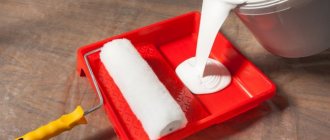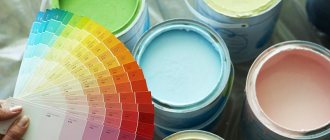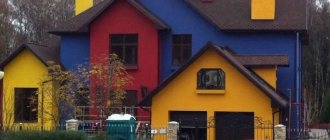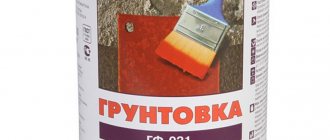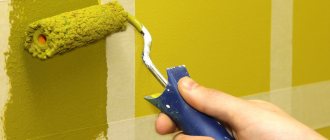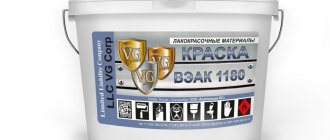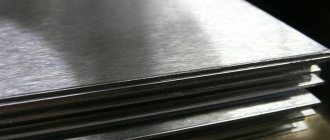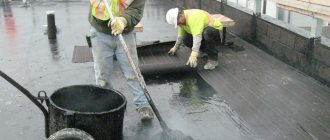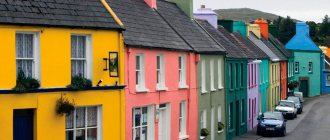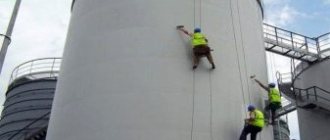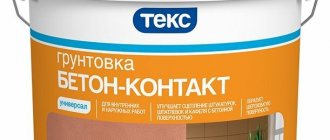Finishing work serves two main purposes. The first, the most obvious and the main one for most, is the creation of a decorative shell, an elegant external appearance of the building.
The second task lies in the plane of materials science and does not appear outwardly in any way, but its importance does not decrease from this. This is the protection of wall materials from the adverse effects of atmospheric moisture, low temperatures and other factors that pose a threat to building materials.
The very first layer that takes the maximum load is the façade paint, which serves as a protective barrier for all wall materials. The durability of all exterior finishing depends on its quality and performance characteristics, which ultimately determines the frequency and amount of costs for cosmetic repairs.
Perchlorovinyl paint - description, composition
Perchlorovinyl paint consists of PVC resin (as a binding component), fillers and pigments dissolved in solvent or xylene . It is one of the most durable facade coverings with valuable qualities and characteristics.
The main and most valuable quality of the material is its versatility. When specializing on concrete or brick bases, PVC paint can be successfully used on all other bases - wood, metal, all types of plaster, etc.
IMPORTANT!
You can familiarize yourself with GOST 25129-82 perchlorvinyl paint at the link.
In addition, the material is very resistant to low temperatures , and there is a specific feature - the paint does not freeze down to -20° and is quite suitable for use, which significantly expands the possibilities of its use.
Another feature of the material is a wide selection of coating colors (about 25 tones), the shade remains throughout the entire service life of the coating and is not susceptible to fading in the sun.
In addition, PVC paints have a good set of qualities common to all external materials - elasticity, vapor permeability, water-repellent properties.
In addition to facade materials, PVC paints have a wide range of applications - metal structures, ship materials, etc., used in difficult or specific conditions.
Staining procedure
Painting with any coloring composition requires preliminary preparation of the surface, and PVC paints are no exception. We have already said that only a building that has gone through a full shrinkage cycle, and therefore not new, should be painted. Therefore, special attention must be paid to cleaning the walls and done thoroughly.
- Concrete, stone or block walls are best treated with a sandblaster. Sand will not only remove old paint well, but will also create the necessary roughness on the surface for better adhesion.
- In the case of installing an insulating layer, a reinforcing mesh must be strengthened on top of it. Next comes the procedure for applying façade putty perchlorovinyl grade XB. Drying. The issue of polishing is decided by the developer in each case separately. Most often it is not needed, this will ensure better adhesion of the paint to the base.
- When it comes to finishing a wooden house, it must first of all be treated with antiseptics and fire retardants. After drying, coat with XB primer.
- It is more convenient to apply paint with a spray gun or roller. Work begins from the top of the wall, working downwards. It is not advisable to use circular movements. To make the surface brighter and more saturated, it is better to use two layers.
You can avoid unnecessary transitions by painting the entire wall in one go. When purchasing paint, you need to take into account that for painting in two layers, the consumption of PVC paint will increase to 400 g/m2.
In addition, remember that real perchlorovinyl paint on the can is accompanied by instructions for use and a link to GOST 25129-82. Everything else is fake.
- Exterior finishing
Advantages and disadvantages
The material has a successful set of useful qualities, including:
- No need for preparatory work - almost all samples do not require priming, etc.
- Deep penetration into the material allows for strong adhesion of the coating, strengthens the structure of the base and protects against external destructive factors.
- The material is supplied in a completely finished form - the paint has a working viscosity that allows the use of sprayers, it can be tinted in 25 color options, giving the user the opportunity to choose a shade to their liking.
- Wide choice and richness of colors.
- The versatility of paint use is suitable for almost all types of surfaces.
- The ability of paint to withstand frost. It is possible to apply the material at temperatures down to -20°.
- Constancy of the color of the coating - there is no ultraviolet fading of the pigment, the paint layer does not change its shade for 3 years.
- It can be applied to metal substrates without the risk of causing rust.
- The elasticity of the film makes it possible to maintain its properties even with minor movements due to shrinkage or vibration.
- High vapor conductivity.
- Relatively low price.
The disadvantages of PVC paint include:
- A pungent odor from the evaporation of volatile components, forcing the use of personal protective equipment (especially when applied by spray).
- The material is flammable; fire extinguishing equipment is required.
What you should know
A few more interesting points:
- On average, consumption ranges from 150 to 230 g/m2. With a two-layer coating, the consumption increases to 400 g/m2.
- You should know GOST for perchlorovinyl paints - 25129-82, since all other products with the same name, but a different code, may be fakes.
- Operational life is at least 10 years. But if stored incorrectly, it can last for a year, after which it can be destroyed.
- Do not keep the container in the sun or in rooms with temperatures below 40 degrees.
Now you know all the features of perchlorovinyl paints, which are ideal for finishing facades. You can learn more about the application process from the video located here.
Perchlorvinyl facade paint HB 161
Perchlorovinyl paint HV-161 is one of the varieties of PVC paints with high performance qualities and technical characteristics:
- High resistance to atmospheric agents and low temperatures. Operating temperature range from -20° to +40°.
- Resistant to aggressive chemicals such as oil, gasoline, etc.
- Dry residue - 43-47%.
- Drying time -4 hours.
- The elasticity of the coating film for bending is 5 mm.
- Resistance to sudden temperature changes - 10 cycles.
- Frost resistance - at least 50 cycles.
- Area of application: external finishing of concrete, brick or plastered surfaces.
Of all the varieties of PVC paints, the XB-161 brand has the highest dry residue, the ability to be applied in frost, and good adhesion to all building materials, which makes it the most preferred representative of its class of materials.
Area of use
HV paints are used to paint parts of the facade of residential buildings and industrial buildings. They are suitable for wood, plastered, concrete, stone, plasterboard or brick surfaces.
For the facade decoration of old buildings, the perfect perchlorovinyl paint XB-182, it forms an excellent coating on a matte basis with a rich color tone .
in a closed room , however, if such a need nevertheless arises, then first of all, the presence of powerful ventilation.
Coatings with HB paint are best suited where the painted surface is exposed to a hazardous environment.
Other types and manufacturers
There are various modifications of PVC paints that are intended for use in different conditions:
- In a temperate climate.
- In a tropical climate.
This division is due to the large difference in operating conditions of the coating in different regions, which requires some changes in the composition and the presence of certain additives.
The most common types in our country are:
- XB-125 . Enamel that does not require prior priming. Contains talc and aluminum chips and a plasticizer as a filler. Used on metal substrates, it can be applied to wooden structures.
- XB-161 . Frost-resistant facade paint, intended for use in temperate climates. Suitable for any substrate, but the main purpose is concrete, plaster or brick.
- XB-182 . This paint requires preliminary priming. It has a smaller dry residue and is used mainly for decorative purposes.
The most commonly used brands of material are listed; the list of PVC paints is much wider, and moreover, it is constantly being updated.
Manufacturers of PVC paints in our country are:
- Paint and varnish plant in Yekaterinburg.
- CJSC PKF Spectr.
- SPF "Emal" and many other manufacturers.
Paint facades twice
The surface is first primed with a white primer of the KhFG brand or a primer made from chalk and 10% perchlorovinyl varnish. With perchlorovinyl paints, which contain zinc white as pigments, facades are painted twice.
It is more productive to apply the paint layer with a paint sprayer, however, when carefully rolling the surface to be painted with a fur roller, a higher quality coating is formed. Experience has shown that the coating turns out to be monochromatic when working with cradles; when working with scaffolding, it is difficult to paint sections of walls covered with tiered flooring. Each subsequent layer of paint is applied after the previous one has completely dried.
Perchlorovinyl paint is used to paint facades at temperatures not higher than 4°C and not lower than -20°C; at higher temperatures, solvents evaporate intensively and difficult working conditions are created. Even at temperatures below 4°C, when the sun is very hot, it is not recommended to paint with perchlorovinyl paint: under the influence of direct sunlight, perchlorovinyl paint dries quickly (within 20-25 minutes), which leads to the formation of lass on the painted surfaces. To avoid this, a solution of laundry soap is introduced into the composition of perchlorovinyl paints, and the paint dries evenly and the painted surface turns out to be uniform. Soap is introduced during the production of paint at the factory: a 10% aqueous solution of soap in an amount of 10% by weight of the paint. In winter, paint is used without the addition of a soap solution, since the aqueous additive freezes in the cold and forms stripes on the painted surface.
Do not apply paint in rainy weather or on a wet substrate, as this leads to the formation of stains on the surface.
In winter, the viscosity of the paint increases, as a result it is poorly applied to the surface and does not pass well through the channels of the paint sprayer. To avoid this, insulate the paint, compressor and paint injection tank (wrapped in felt, heated with blowers), replace hoses of normal cross-sections (for supplying material and air) with hoses of a larger cross-section. It’s easier to paint facades in winter using fur rollers and heat the paints in a water bath.
Currently, for finishing facades, especially when renovating old buildings, modified perchlorovinyl paints XB-182 are widely used, which contain a plasticizer - polyethylene glycol adipate dibutyl ether (PDEA).
XB-182 paints are intended for finishing facade surfaces of brick, plaster, concrete, and wood. The formation of the film occurs due to the evaporation of the solvent - xylene, which makes it possible to finish facades in the winter season.
Painted surfaces are characterized by high decorative properties, which meets the requirements of modern architecture. The facades are painted twice: primed with a composition with a viscosity of 45-50 s (according to VZ-4), after the primer coating has dried, paint is applied.
HV-182 paints can be applied with a roller, brush, or spray.
Characteristics of XV-182 paint: viscosity (according to VZ-4) at a temperature of 20°C - 60 s; Drying time at a temperature of (20±0.5)°C - no more than 23 hours, paint coverage - 200g/m2.
When painting the facades of occupied buildings, apartment windows are tightly closed.
Upon completion of work, brushes, rollers and paint sprayers are washed in solvent. The most common defects on surfaces painted with perchlorovinyl paint, the causes of their occurrence and methods of elimination:
What surfaces is perchlorvinyl paint suitable for?
The main area of use of PVC facade paint is building materials:
- Concrete.
- Brick.
- Plaster bases of various compositions.
At the same time, there are materials specialized for finishing metal or wood. In general, PVC paints have a wide range of specifications for use in a variety of applications where conventional materials are not suitable. For example, there are materials for finishing ships used in fresh or sea water, metal structures, chemical equipment, etc.
Basic properties of the material
Perchlorovinyl facade paints are inexpensive and provide good protection to the external surfaces of walls. Easy to apply and long lasting. The main characteristics of the material are presented in the following table:
| Indicator name | Unit | Quantity |
| Viscosity | Pa. With | 30-45 |
| Drying time | hour | 24 (at temperature +20°) |
| Consumption | g/m2 | up to 270 (with a layer thickness of 25 microns) |
| Grinding degree | µm | up to 30 |
The viscosity indicator indicates that paints made on the basis of perchlorovinyl resin can be successfully applied using spray guns or other sprayers. You just need to remember the safety rules. Since these dyes emit volatile substances when applied and dried, you must work in a respirator, goggles and gloves.
The advantages of PVC paints include:
- the ability to create a powerful coating that perfectly protects the surface of the walls from any external influences;
- high adhesion to the finished surface of almost any material - concrete, wood, brick and blocks, as well as to plastered facades;
- the ability to perform painting work at sub-zero temperatures.
Perchlorovinyl facade paints offer a wide range of rich, deep colors. The surface they paint retains its original appearance for many years.
